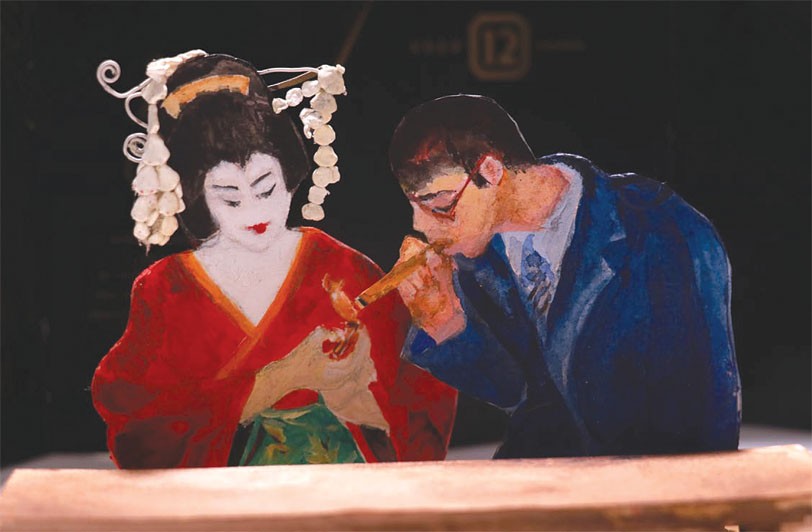
Masooma Syed’s latest works at Canvas Gallery Karachi not only remind us of our socio-political conditions but also the personal history of the artist

One is not sure how the police constables react here when they catch a person smelling of or carrying alcohol. But there is certainly no charge against those who get hold of empty cases or bottles. Thus, shops in major cities sell empty alcohol bottles to be used for keeping indoor plants or for painting still-life. Occasionally, you get low-priced notebooks with covers of recycled whisky boxes.
Masooma Syed has used the same stuff to produce her new works displayed at her solo exhibition Spirits being held from Feb 6-15, 2018 at Canvas Gallery, Karachi. She has collected cases of various bottles; cut, joined and composed them to construct objects which look like set designs, small scale models of various enclosures, or facades of buildings.
Fabricated with utmost care, these works present haunting scenarios; reminding of dead people, destroyed places and distant periods -- hence the title of the show Spirits.
But spirit or spirits is also a word to denote ‘strong distilled alcoholic drink’, and for ‘volatile liquid prepared by distillation’. If you read the accounts of people who consume liquor, at times they invoke spirits in their hallucinations; they also describe seeing other-worldly beings in familiar entities. They claim that their own spirits are high when they’re intoxicated.
Syed synthesises all these meanings, connections and connotations in her art, but apart from these literal links her work is about revisiting another world. A realm that survives beyond the periphery of ‘normal’ set of things; and belongs to dreams, literature, cinema and other forms of art. However, her mode of making these highly imaginative and provocative pieces is such that one starts believing in the ‘truth’ of these fabrications. Much like constructed histories, which in reality are fictions weaved by certain groups and (ruling) classes. But these artefacts of artificial past are presented in such a scheme that one cannot contest the authenticity of these narratives.
References to wars, theatre backdrops, Disney Land and religious monuments can be traced in Syed’s works which, despite having the labels of various liquor manufacturing companies, are grim in their essence/atmosphere. In particular, the mixed media Greys (photograph, paint, wood, cardboard, foam board, silk cloth, LED lights and acrylic sheets) are built with different screens and interjected with small objects. Pictures of a woman sitting in a room, sacks piled up and traces of a bed inside another space, all enhance associations with a war-trodden land and conflict-inflicted era.
However, Syed infuses a sense of poetry and lyricism in this work by treating every component of her visual vocabulary in varying shades of grey. Hence the title of the work Greys. But one feels that more than the tones of a colour, it alludes to the testimonies of the past -- battles, desolations, destructions.
Masooma Syed develops a scene which is about passion, be it negative or positive. As love, hate, envy, spirituality and religious experiences elevate you, war hysteria and hype also raise your spirits. In her other constructions, one locates links with settings which reflect family relationships, intimate or public spaces. Yet she twists otherwise normal situations with some uncanny addition. For instance, a colonnade in scarlet (Golden Spirits) is crowded with cut-outs of vultures perched on top. Red cardboard in a strong light represents a specific era: romantic and traditional. But the artist includes an ironic element: the name of an alcoholic brand that can be easily read.
The juxtaposition of religious architecture and prohibited stuff highlights the contradictions of the society. The distance between piety and profanity is mapped through the common factor of gloom, which awaits the two attitudes/behaviours.
This contradiction or hypocrisy is highlighted through multiple forms. For instance, the mosque-like structure which in a sense reminds of Disney Land but consists of ‘banned’ beverage boxes. The interplay of light in all these works adds a dimension of drama, or a kind of hyper reality. In our everyday lives, the presence of light is a matter of routine that often goes unnoticed. But while watching a theatre performance about some aspect or episode of human existence, a strong light is projected from above, so the actors, props and background are fully visible.
In Syed’s settings, light illuminates her content in the same way as the cut-outs of a few figures placed in the shallow space in front of architectural details communicate certain phases in human history. For instance, men wearing stripped dress in ‘Dear Love’ along with a few characters singing and playing music resurrect an epoch that can be identified with the mid-twentieth century.
The blend of two-dimensional pieces and three dimensional ‘models’ of sacred or significant buildings contributes towards a larger understanding of the world -- or us. Here, everything is an illusion. A play is performed for a few hours, and an act in reality also takes place for a predetermined period. Life, no matter how long it seems, ends after some years.
Thus Syed’s work survives on the common territory between actual and staged life. Both spans conclude with the disappearance of the main protagonist. She has created a few works in which the idea of illusory scenarios is dominant, particularly in the context of South Indian region.
These works, on many levels, remind of the socio-political condition of our region, but at the same time reveal the personal history of the artist. Syed has been living in Sri Lanka after her marriage, a temporary home, which she leaves to go to India or come back to Pakistan for brief periods. She is a person who is the citizen of different democracies. But her real home, which for every creative individual in the words of Rushdie is her art, which she has built, resides in, invites others to visit and carries it wherever she goes in this -- the politically split planet.